There are few times over the course of the season that are as exciting as the trade deadline. To be sure, the entry draft is always a time filled with promise and excitement, with the opportunity to bring in a new batch of players to track for the next few years in hopes your team will stumble upon the next superstar. Free agency can be a ton of fun as well, as everyone waits and watches to see if their team will be the ones to reel in one of the biggest fish sitting on the market. Still, especially for contending teams, the trade deadline can be the difference between a first-round exit due to a glaring hole that went unaddressed or a championship run.
For the Carolina Hurricanes and general manager (GM) Don Waddell, this trade deadline looms large. The team clearly has some holes that could be filled on the trade market, especially as players have continued to get banged up in recent weeks. The defense looks like the most obvious group that needs a boost, something I’ve mentioned in recent posts a handful of times. This looks even more pressing with Tony DeAngelo leaving the last game in Philadelphia, less than 24 hours after Brendan Smith left the action against the Pittsburgh Penguins.
It will be fascinating to see what unfolds over the next few weeks, and there are already some highly-intriguing options reportedly available that we’ll dive into soon. Today, though, we’re going to take a look back at some Hurricanes history and how they’ve navigated the trade market over the last few years. I’ll give my ranking of the best and worst deadline deals the franchise has completed since relocating to Raleigh and then do a quick recap of the last five trade deadlines and what moves exactly the franchise pulled off. Perhaps a little look at the past can give us a hint of what’s going to happen over the next month. Or maybe not, but let’s take a stroll down memory lane anyway!
Hurricanes’ 5 Best Trade Deadline Moves
*Note: I decided a January cutoff seems fair, even though they’re not exactly “deadline deals;” sometimes teams make their moves a little earlier, as we’ll see below, so I figured broadening it a bit would make this a little more interesting.
5. Jan. 16, 2002: Hurricanes Acquire Bret Hedican, Kevyn Adams, Tomas Malec and a Conditional 2003 Second-Round Pick for Sandis Ozolinsh and Byron Ritchie
Sandis Ozolinsh was a highly underrated Hurricane and defenseman in general, as he posted huge numbers during his Colorado Avalanche days, especially. His Carolina tenure was short, though, and came at a time that hockey hadn’t really blown up in the area the way it has now. The team was really put on the map this very season after he was traded away, and Adams and Hedican both played large roles in that run to the Stanley Cup Final.
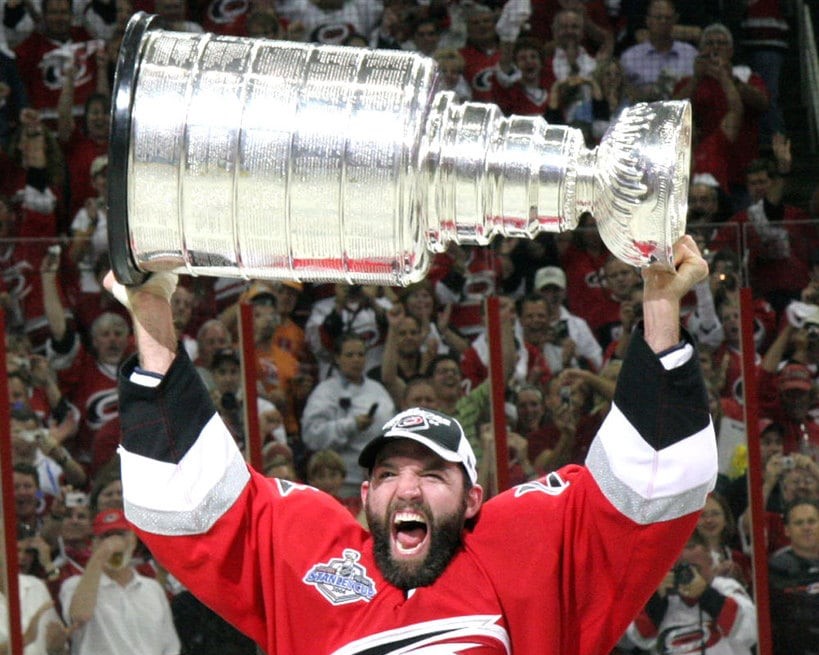
Then, in 2006, they would both serve as leaders on the squad that broke through and won it all, with Adams serving as an alternate captain. Hedican, meanwhile, ate huge minutes on the blue line and was one of the best skaters among defensemen in the league. This trade played a huge role in building the core that would bring the Stanley Cup to Raleigh.
4. Jan. 17, 2019: Hurricanes Trade Victor Rask to the Minnesota Wild for Nino Niederreiter
We will talk more about this trade below, so I’ll keep it relatively short here, but what a job this was (and what a mistake by former Minnesota GM Paul Fenton). Niederreiter was a huge part of the Hurricanes’ run towards their first playoff spot in a decade, as he formed a new-look top line next to Sebastian Aho and Teuvo Teravainen that was dominant down the stretch. The former fifth overall pick would pot 14 goals and 30 points in just 36 games following the trade. He has been a key member of the Hurricanes’ top-nine ever since, fitting extremely well as one of the few true power forwards on the roster who makes his living by making life miserable for opponents in the dirty areas.
3. Feb. 24, 2020: Hurricanes Acquire Vincent Trocheck From the Florida Panthers in Exchange for Eetu Luostarinen, Chase Priskie, Lucas Wallmark, and Erik Haula
The next year, Waddell was at it again, and I still find this move to be objectively hilarious. The Hurricanes were able to add a second line, all-situations center with term remaining on his contract without giving up one top prospect or draft pick. How many times has that happened, like, ever? I did and still do like Luostarinen as a bottom-six player with a little skill, and Haula was fine as a depth player with a little snarl in his game, too, but the other two were AHL-caliber players. This is a good example of four quarters not equalling a dollar, and the Hurricanes won this trade by a mile.
2. Jan. 30, 2006: Hurricanes Acquire Doug Weight From the St. Louis Blues in Exchange for Mike Zigomanis, Jesse Boulerice, and Three Picks, Including a First-Rounder in the 2006 NHL Draft
March 9, 2006: Hurricanes Acquire Mark Recchi From the Pittsburgh Penguins in Exchange for Niklas Nordgren, Krys Kolanos, and a 2007 Second-Round Pick
Yes, I cheated a bit here in including two separate trades, but these deals clearly go hand-in-hand. During the 2005-06 season, the Hurricanes were atop the standings basically all year after being picked by most media outlets as a bottom feeder before the season. They showed they were serious about contending at the deadline, trading for two high-end veterans, both of whom waived their no-trade clauses in order to join the team. Obviously the move paid off, as the pair played big roles in leading the franchise to its only Stanley Cup. Both players took a second to get acclimated and didn’t light up the scoresheet in the home stretch of the regular season, but both came alive in the postseason with 16 points apiece. That kind of production and a championship is more than enough to warrant the second spot here.
1. Jan. 20, 2004: Hurricanes Acquire Justin Williams From the Philadelphia Flyers for Danny Markov
All those other moves were great, but, honestly, the best deadline deal the Hurricanes have ever pulled off was no contest. The Flyers completely botched this one, sending a 22-year-old recent first-round pick to Carolina in exchange for a hard-nosed, veteran defenseman. With an impending cap crunch, Markov would last just 52 games for the Flyers (18 of those being postseason contests) before being traded to the Nashville Predators. Perhaps, though, they would have had more than those 18 playoff games had they kept the youngster who would go on to earn the nickname “Mr. Game 7” and win three Stanley Cups in the process.
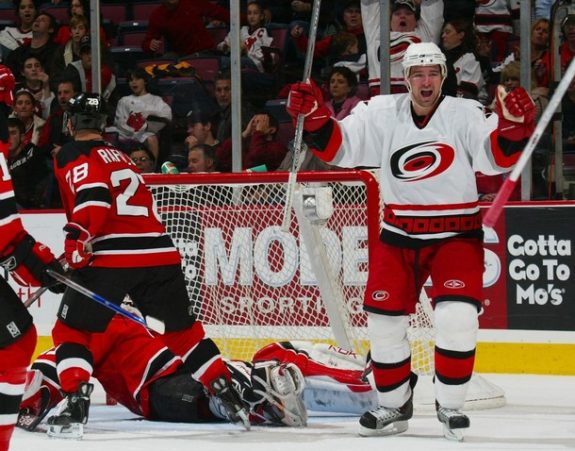
Williams was a central figure in leading the Hurricanes out of dark eras on two separate occasions, including his first full season with the organization in 2005-06. He scored 31 goals and added 45 helpers on the year, plus another 18 points during the Stanley Cup run. His initial tenure lasted just four-and-a-half years, but after stops in Los Angeles and Washington, he returned nearly a decade later alongside his good friend and former teammate Rod Brind’Amour to lead the team back to relevancy. There was something special about watching him lead the next generation of Carolina stars while serving as captain under his former captain. Williams was the perfect buffer between the coach and his teammates, and he played a huge role in implementing a new, winning culture in Raleigh.
Carolina’s Five Worst Deadline Trades
5. April 3, 2013: Hurricanes Trade Jussi Jokinen ($900,000 retained) to the Pittsburgh Penguins in Exchange for a Conditional Pick
To kick off the worst trades, in this season, the Hurricanes weren’t very good, and while the shootout specialist was great in his Carolina career, it was probably the right time to move on. This still makes the list, and it’s at least partially because the team got next to nothing for a player who clearly had good hockey left in him, which became highly obvious when he kicked off the next season with a hat trick against his former team in the first week of the season — while they were still paying him! Talk about insult to injury — and he actually scored five goals in his first three games against Carolina following the deal. Jokinen would go on to score 11 points in 10 games following the deadline move, and then 21 goals and 57 points that following season for Pittsburgh.
4. Feb. 7, 2003: Hurricanes Traded Sami Kapanen and Ryan Bast to the Philadelphia Flyers in Exchange for Pavel Brendl and Bruno St. Jacques
Just one year after posting career-highs in both goals (27) and points (69), the Hurricanes traded the fan-favorite, blazing-fast winger for a former fourth overall pick whose biggest claim to fame is being a key piece in the deal that sent Eric Lindros to New York. Kapanen would have a couple of decent seasons in Philadelphia, although he never regained his scoring touch from his earlier Carolina days, before returning to his native Finland to finish out his career.
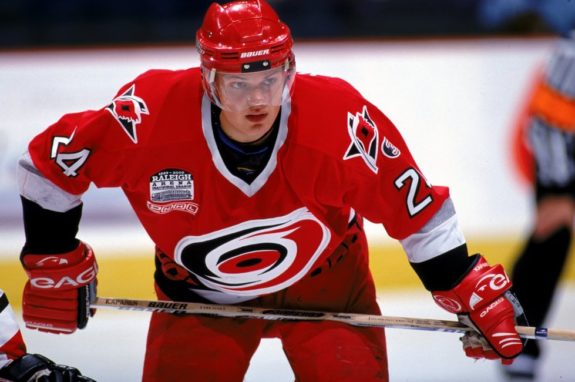
While Brendl looked like he had the potential to develop into a premier goal-scoring threat while tearing up juniors for the Calgary Hitmen of the Western Hockey League (WHL), he never came close to panning out in the NHL. He would play in only 26 games and score just five goals for Carolina before bouncing around Europe for most of the next decade. St. Jacques, meanwhile, showed some promise in his 18-game Carolina stint as a 22-year-old but would end up playing just 67 total NHL games before going to the German Deutsche Eishockey Liga (DEL) and, eventually, his native Quebec to play in the Ligue Nord-Américaine de Hockey (LNAH), a low-tier professional league.
3. Feb. 11, 2008: Hurricanes Acquire Joe Corvo and Patrick Eaves in Exchange for Cory Stillman and Mike Commodore
One of my favorite players to ever watch in a Hurricanes sweater, Stillman was an excellent pickup during that magical 2006 season, scoring at over a point-per-game pace in both the regular season and playoffs and coming up with some of the team’s biggest goals during that postseason run. Meanwhile, Commodore was a fan favorite thanks to his awesome hair and stunning fashion statements (this is sarcasm; it was literally just a bathrobe, but it became quite the phenomenon at the then-RBC Center in ’06).
Related: Carolina Hurricanes Jersey History
It definitely stung when those two were traded away for two players that didn’t end up matching their value. Eaves had shown some scoring ability with the Senators but never regained that 20-goal scoring touch until an outlier age-31 season with the Dallas Stars. He scored just seven goals in 85 games over two seasons with Carolina. Corvo did have some nice seasons with the Hurricanes as a power-play specialist, including twice hitting double digits in goals. However, inconsistencies and letdowns in his own end worked against him.
2. Feb. 24, 2020: Hurricanes Trade Janne Kuokkanen, Fredrik Claesson, and a Conditional 2020 Draft Pick to the New Jersey Devils for Sami Vatanen
The Hurricanes’ blue line needed a few pieces with Brett Pesce’s season-ending injury ahead of the 2020 postseason, and, alongside Brady Skjei, the team went out and added a power-play quarterback from New Jersey. However, COVID complicated things, in addition to him being hurt when the trade went down and therefore not getting on the ice for a handful of games. When he did get on the ice with his new team, Vatanen wasn’t particularly good in the whopping seven games Carolina got out of him. This mostly stings because of Kuokkanen, who has turned into a nice piece for the Devils, though there is an argument to be made that he didn’t fit the Carolina system particularly well with his playing style and not-great skating ability.
1. Feb. 26, 2008: Hurricanes Trade Andrew Ladd to the Chicago Blackhawks for Tuomo Ruutu
It’s not quite as bad as the Markov for Williams swap was, but this was another example of a team giving up on a first-round pick a bit too early. Not that I didn’t appreciate Ruutu’s contributions during his time in Carolina, as his heavy hits and timely goals led to him quickly becoming a favorite amongst the fanbase. Still, in comparison to the career that Ladd would go on to have with over 250 goals and 500 points, it feels like the Hurricanes made a hasty decision, giving up on higher upside to get immediate production from an already-proven player.
They then had to watch from afar as Ladd became a consummate pro, great leader, and solid, top-six scorer, serving as Winnipeg/Atlanta’s captain for six seasons, plus as an alternate with the New York Islanders for three more seasons. Even though Ruutu would hit the 50-point mark twice in Carolina (out of six seasons), Ladd went on to be a consistent 50-60 point player basically every year before injuries began wearing the power forward down in his 30s.
Hurricanes’ Deadline History
2016-17: Hurricanes Trade Viktor Stalberg to Ottawa for a Third-Round Pick; Hurricanes Trade Ron Hainsey to Pittsburgh for Danny Kristo and a Second-Round Pick
Ah, the Ron Francis years. What a time.
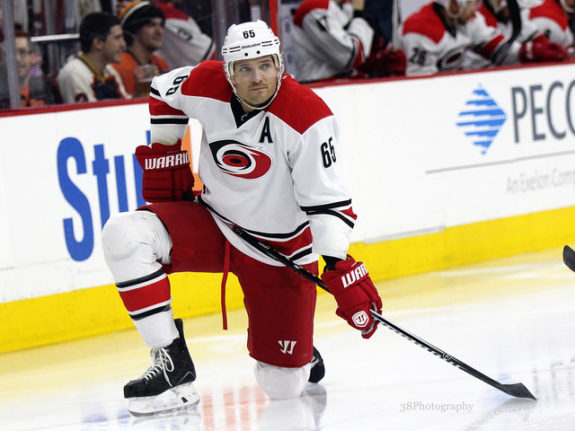
The Hurricanes kind of stunk this season, finishing with 87 points and a 36-31-15 record. With the team never really threatening for a playoff spot, this year was really all about the future; a 19-year-old rookie by the name of Sebastian Aho put forth an extremely strong year for his age, and two 21-year-olds in Elias Lindholm and Teravainen looked like legitimate building blocks alongside him in the forward core. Things were looking up, but it wasn’t quite time yet, so Francis took to selling, picking up second- and third-round picks in the 2017 draft. Those two picks would later be flipped for two roster players for 2017-18 in Scott Darling (oof) and Trevor van Riemsdyk.
2017-18: Hurricanes Did Nothing. Really.
This was incredibly frustrating at the time, as the Hurricanes were basically right on the verge of a playoff spot when the trade deadline came… and went. Were the Hurricanes going to sell off veteran free-agents-to-be in Lee Stempniak or Derek Ryan? Would they go for it after nine years of playoff-less hockey in Carolina and some fun, young pieces on the team? The answer was… neither. Francis sat on his hands, the team missed the playoffs, and he didn’t pick up any future assets for those aforementioned unrestricted free agents (UFAs) that left town for nothing that summer.
I guess “they did nothing” isn’t really an accurate statement, since the team did pick up the legendary Greg McKegg from Pittsburgh in exchange for Josh Jooris. Still, no matter how you look at it, this was a big-time failure from Francis, and probably one of the final nails in his coffin which shut a few months later. Which, I guess, can be seen as a good thing for the franchise in retrospect; they seem to be doing okay now. Still, I wonder how then-brand-new owner Tom Dundon felt watching all of the nothingness unfold.
2018-19: Traded Victor Rask to Minnesota Wild in Exchange for Nino Niederreiter; Traded Cliff Pu to Florida for future considerations
The Hurricanes returned to relevancy this season, and even though Rask was traded a good deal before the deadline, the acquisition played a monstrous role in the team making the postseason. As mentioned above, Niederreiter jumped right onto the team’s top line and played a major role in their offense as the team became a postseason participant for the first time in a decade. New general manager Don Waddell didn’t need to add a ton, as the team wasn’t truly ready to compete for a championship yet, but this move still played a huge role in the team’s hot finish to the year and playoff qualification and continues to pay dividends today. The Swiss-born winger is having a great year, once again.
2019-20: Traded Julien Gauthier to New York Rangers for Joey Keane; Acquired Vincent Trocheck from Florida Panthers for Eetu Luostarinen, Chase Priskie, Lucas Wallmark, and Erik Haula; Acquired Sami Vatanen from New Jersey Devils for Janne Kuokkanen, Fredrik Claesson, and a fourth-round pick; Acquired Skjei from New York Rangers for a first-round pick
This was the first time we really got to see a well-acclimated Waddell wheel and deal, and he showed his propensity to target players who weren’t simply rentals. The Vatanen deal was the exception, both in terms of production and term. However, Skjei and Trocheck have each become key parts of the Hurricanes since, with the former teaming up with Brett Pesce to form a highly reliable, shutdown second pairing (and he’s broken out offensively now that he’s finally gotten a mostly normal season with the team this year, too), and the latter being a feisty, two-way, second-line center who has played a lot of hockey in all situations since coming over.
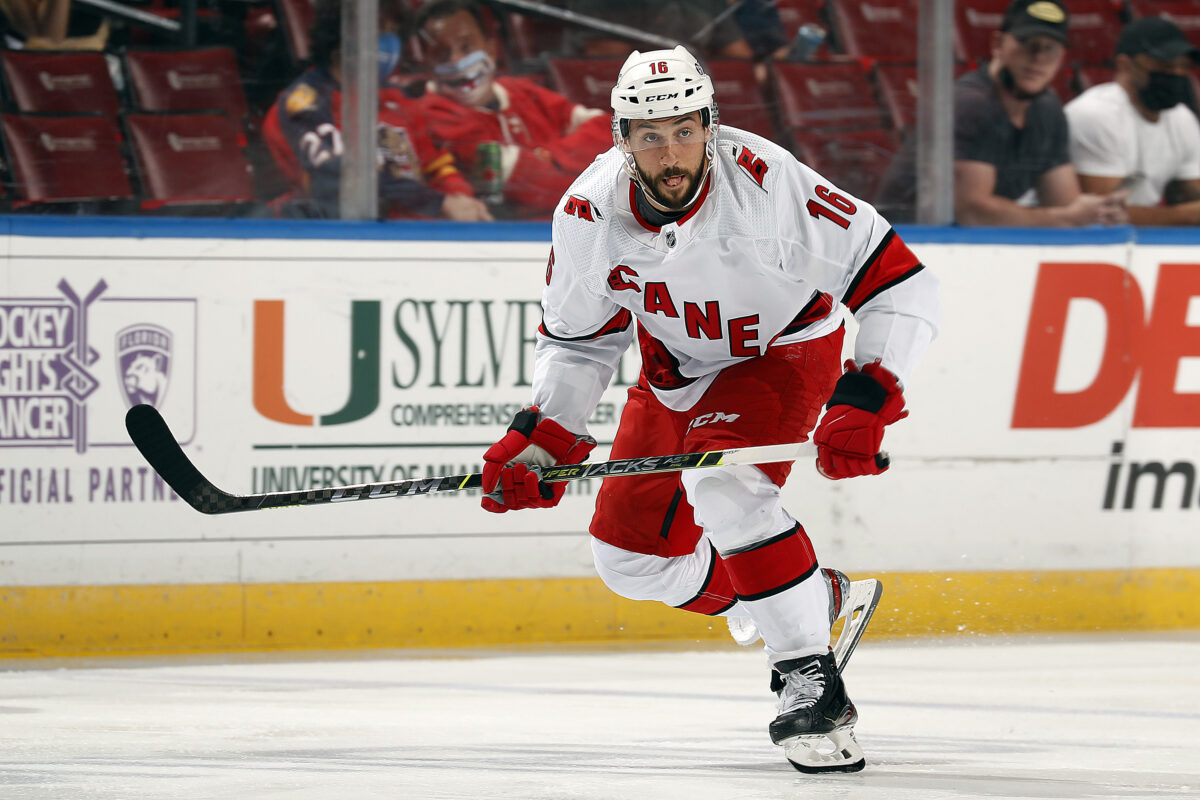
It was an excellent deadline for Waddell, all told, as he was able to acquire long-term assets and not have to sell off a large, hurtful chunk of his farm system in the process. Getting Keane, who I think has a chance to turn into a second-pairing defenseman thanks to his skating ability, offensive development, and overall versatile game, looks like it may be a very nice cherry on top. I expect to see him break into the NHL full-time next year.
2020-21: Acquired Cedric Paquette and Alex Galchenyuk from Ottawa Senators in Exchange for Ryan Dzingel; Flipped Galchenyuk to Toronto Maple Leafs for Yegor Korshkov and David Warsofsky; Traded Haydn Fleury to Anaheim Ducks for Jani Hakanpää and a Sixth-Round Pick
On the flip side, last year, the Hurricanes front office obviously didn’t think the team needed to make big changes, instead choosing to largely stand pat and add a little grit and physicality. Neither Hakanpää nor Paquette made a substantial impact with the team, but both were helpful, physical pieces on a team that was lacking in that particular area. Many fans of the team were hoping for a bigger move, especially in hindsight after they fell short in the postseason. But, as Waddell has proven time and again, he’s not going to overpay just for the sake of making a deal. On the bright side, with the team now sitting near the top of the league standings in 2022 and looking like a true contender, they still have a stocked pipeline of future talent that, perhaps, a deal at last year’s deadline would have weakened.
What Does This Mean for Carolina’s Deadline in 2022?
Well, outside of the last sentence above, likely nothing. It’s hard to say if the Hurricanes’ front office feels like the team is in dire need of another piece, so perhaps we could see the deadline come and go similarly to last year with a few minor deals for depth players, and that could be it – especially with the team’s lack of first-round pick in the coming draft as a trade chip. On the other hand, with the aforementioned DeAngelo and Smith injuries in the last week and the fickle nature of “championship windows,” the team could feel a pressing need to add a legitimate piece. It’s equally logical that we could see another 2020-esque deadline where they are in the market for some higher-up-the-lineup talent.
It all comes down to how the market materializes, which we’ll see and talk about plenty over the coming weeks. There are already rumblings about a handful of big pieces that could potentially be on the move, with Arizona Coyotes defenseman Jakob Chychrun the subject of many rumors (and reported interest from Carolina), veteran star Claude Giroux looking like the best rental option available, and rumors surfacing just yesterday that Nashville Predators sniper Filip Forsberg is being shopped, too.
One of the exciting, rumor-filled times of the year is upon us, and the Hurricanes remain well-positioned to make competitive offers on just about any caliber of player that may be available over the coming weeks. With that said, in the coming days, we’ll start to break down what the Hurricanes could be in the market for and what players they could potentially be targeting to fill those needs as they gear up for a run at a Stanley Cup. Be sure to check back regularly as we cover all the news, rumors, and scenarios that bubble to the surface in the NHL headlines, right here at The Hockey Writers.